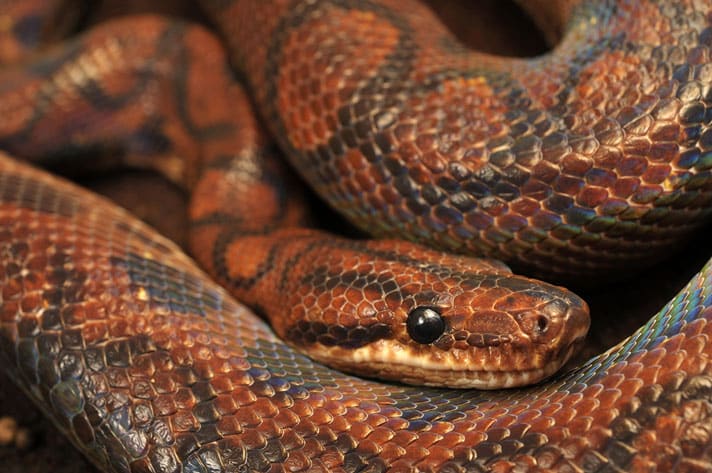Updated January 31, 2023 Care sheet for Rainbow Boas (Epicrates Cenchria) Argentine rainbow boas (Epicrates Cenchria) are considered to be one o
Updated January 31, 2023
Care sheet for Rainbow Boas (Epicrates Cenchria)
Argentine rainbow boas (Epicrates Cenchria) are considered to be one of the more beautiful snakes in the world. Not only do they display vibrant orange and red coloration, but they also produce an abundant amount of Rainbow iridescences. Microscopic ridges on their scales that refract light cause this phenomenon. Rainbow boas inhabit a large geographical range including South America and lower Central America. The rainbow boa group currently (as of 2008) consist of five subspecies:
Common Names
Brazilian, Peruvian, Espirito Santo (E.C.Cenchria)
Paraguayan, Central Highlands (E.C Crassus)
Colombian, Marajo Island (E.C Mauro’s)
Coating (E.C Assisi)
Argentine (E.C Alexei)
However only two subspecies are imported regularly. Brazilian rainbows (E.C. Cenchria), and Colombian rainbows (E.C. Maurus) are the most commonly kept rainbow boas.
Rainbow Boa Availability
Rainbow Boas are readily available and can thrive in captivity with proper snake supplies, and careful attention to reptile health and wellness. They can be found at exotic pet stores, and at any local reptile show. Genetic mutations (Morphs) are available as well, however they are very rare in collections and come bearing a large price tag.
Rainbow Boa Size
Rainbow boas are born measuring about 8 to 12 inches. Adults reach an average length of 5 to 6 feet; Females tend to be slightly larger than males in both girth and length.
Rainbow Boa Life Span
With the proper care, captive rainbow boas on average live 20+ years. There have even been recordings of females reproducing at the age of 24 years old.
Rainbow Boa Lighting and Temperature
When it comes to reptile heating and lighting for the Rainbow Boa, the ideal temperatures for rainbow boas are a night time low of mid to low 70’s Fahrenheit and a day time high in the low 80s F. High humidity is essential for Rainbow Boas. Daily misting should be used to maintain humidity between 75-90 percent for adults and 95 to 100 percent humidity for neonates without the substrate being wet. A thermal gradient is also recommended. This is easy to achieve by using heat pads, and/or overhead lighting or snake heat lamp, or radiant heat panels. Subspecies such as Brazilian rainbow (E.C. Cenchria) are more sensitive to higher temperatures and should never be in prolonged temperatures over 90 F (unless being a gravid female). Colombian rainbow boas (E.C Maurus) tend to have a higher tolerance for both higher daytime temperatures, and lower night time temperatures, thus making this subspecies slightly easier to keep than the Brazilian. I strongly recommend using a thermostat to regulate proper temperatures. By using a thermostat you can ensure that your enclosure will never be too hot, or too cold, and has proven to be an important tool to create optimal breeding conditions.
The key to have your rainbow boa “glow” is light. A low wattage fluorescent light mounted overhead will provide a beautiful rainbow display to your snake. Rainbow boas are primarily nocturnal, so you will want to make sure your ambient lights turn off for a night cycle of 8-12 hours using a timer. Ambient lighting is also important for any live plants you might use to decorate your terrarium.
Rainbow Boa Substrate
The ideal snake bedding for rainbow boas is one that can withstand moisture without molding or breaking down. Some of these substrates include high grade reptile mulch, like cypress, and coconut products like coco coir. Both sphagnum and green moss are a great way to visually enhance the look of your reptile terrarium, while providing extra moisture and increasing humidity. It is also important to provide some kind of hide for your rainbow boa. I like to use large pieces of cork flats in my exhibits.
Rainbow Boa Food
Rainbow boas are generally voracious eaters enjoying frozen or live reptile food. In the wild their diet consists of small mammals, rodents, birds, bats, and even small lizards including tegus (Tupinambis merianae). A variation in their captive diet has not been proven to be necessary, and can suffice on an all-rodent diet.
Rainbow Boa Water
Proper humidity and available clean water is crucial for keeping a healthy rainbow boa. Most rainbow boas thrive with humidity levels of 70 percent and higher, however Colombian rainbows (C.C.Maurus) are known to thrive in humidity levels as low as 50 percent. Dehydration and overheating are the two most common causes of mortality in rainbow boas. Signs of dehydration include: incomplete sheds, wrinkly dry scales, and regurgitation. A water source big enough for your snake to soak in is very important, and should be changed frequently to avoid dirty stagnant water.
Rainbow Boa Handling and Temperament
Rainbow boas are generally docile and can withstand regular handling, however neonates (babies) tend to be a little nippy for the first few months. This behavior is a natural instinct for survival, but after a few meals and some time to adjust to new surroundings they seem to tame down and become great companions.



